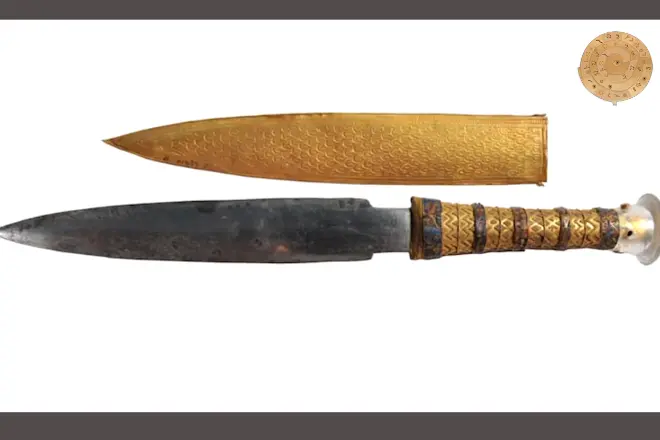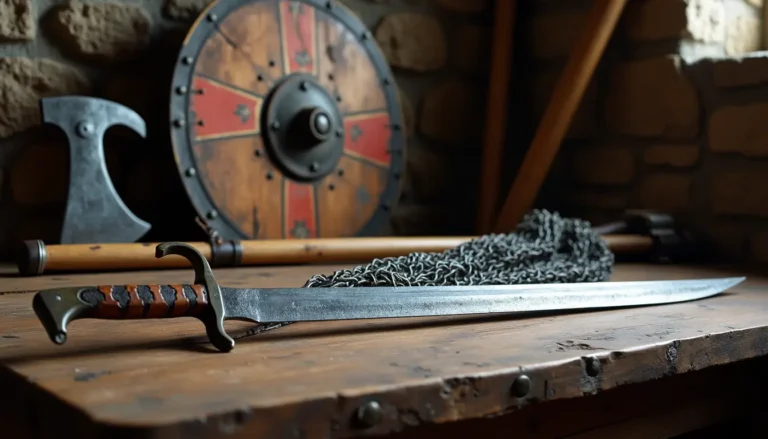Iron in the Bronze Age: Where did King Tutankhamun get his Dagger?

The Bronze Age was a time of great change and innovation, particularly metallurgy. It was also a time of great wealth and power, as evidenced by the incredible treasures. Those treasures have been uncovered in the tombs of pharaohs like Tutankhamun’s. One of the most fascinating and mysterious treasures is the king Tutankhamun’s dagger found among the king’s burial goods.
This dagger, known as the “Dagger of Tutankhamun,” has long been the subject of debate and speculation, with many experts wondering where the iron used to forge it came from. This article will explore the evidence of what it was made of and where it came from in the mysterious Bronze Age.
Along the way, we’ll also explore the broader context of Ancient Egypt and its incredible history, including fascinating discoveries like the recent temple to the Egyptian Sun God Discovered Near Cairo.
What is King Tutankhamun’s Dagger?

king tut’s meteorite dagger is one of the more mysterious pieces of ancient Egyptian art and currency. It is a simple yet elegant weapon, approximately 16 inches in length. It is made of iron and has a golden handle inlaid with precious stones. The blade is finely crafted and appears to have been made using the technique of pattern welding. It was a method of forging multiple iron bars together to create a stronger, more durable weapon. The dagger was found in the pharaoh’s tomb in the Valley of the Kings in 1922, among a trove of incredible treasures that included golden masks, jewellery, and other artefacts.
The Possible Origins of the Dagger
One of the most intriguing theories about the origin of the iron used to make the Dagger of Tutankhamun is that it came from a meteorite. This theory is based on the fact that iron was extremely rare in ancient Egypt. The iron used to make the dagger appears to have a high nickel content, characteristic of meteoritic iron. If this theory is correct, it will make the dagger one of the oldest known examples of iron made from a meteorite. It would shed new light on our understanding of the Bronze Age and the role of iron in early civilizations.
Meteoric Iron in the Bronze Age
Meteoric iron, or ‘Iron from Heaven’, is known for its distinctive properties. It allowed it to be used for tools and weapons of considerable strength and hardness. While it was not as prevalent as earthly iron ore, it was known to have been used in some of the more extravagant items of the time, such as dagger of Tutankhamun.
Ancient Blacksmithing Methods

One must first look at the ancient blacksmithing methods to understand how King Tut’s dagger was fashioned. These methods relied on an intense heating and cooling process and a unique mixture of components. This mixture often included meteoric iron, earthly iron, and silver. It would have been used to craft such items.
Other King Tut Daggers
In addition to the famous iron dagger, several other daggers were found in King Tutankhamun’s tomb, all of which were made of bronze. These daggers were also finely crafted and decorated with gold, precious stones, and other materials. They provide a fascinating glimpse into the wealth and power of the pharaohs of ancient Egypt. They also demonstrate the importance of the following:
- metalworking and metallurgy during the Bronze Age
- the skill and creativity of the metalworkers
- artisans who created these remarkable weapons
The Mystery Solved?
Only further research and examination of the dagger can definitively determine its origin. The evidence points to a craftswoman with a speciality in meteoric iron being responsible for the creation of King Tutankhamun’s dagger. This suggests that the craftswoman acquired a good quality meteoric iron and used their talents to craft a dagger fit for a king.






